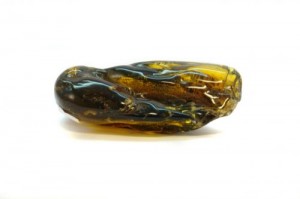Fake amber is easy to make from surrogate materials such as colored plastic, copal and modern polymers, but some of it is also easy to identify. There are a few ways to identify fake amber and also several simple tests to recognize real amber.
 Before you can learn to recognize whether amber is fake or real, you must learn some general facts about amber. There are few places in the world were real amber is excavated and the Baltic area is one of them. Here, millions of years ago, the climate grew warmer and pine trees or eucalyptus trees produced the resin which fossilized and became amber.
Before you can learn to recognize whether amber is fake or real, you must learn some general facts about amber. There are few places in the world were real amber is excavated and the Baltic area is one of them. Here, millions of years ago, the climate grew warmer and pine trees or eucalyptus trees produced the resin which fossilized and became amber.
In South America, there are various species of leguminous trees, smaller plants with nodules inside their roots. Here, bacteria put nitrogen back into the soil. The resin produced by these leguminous trees can turn into amber when proper conditions are achieved, even though it is partially polymerized so it can't be considered real amber. These resins are called copal, a surrogate material for real amber. In comparison to real amber it is less dense, with a specific gravity of 1.03 to 1.08, while real amber shows a gravity of 1.05 to 1.10. Since 1 is the same gravity as water, materials that are denser than this value will sink in fresh water.
So both amber and copal will sink in fresh water. And since salt water has a higher density, both of them will float in it. You can approximate salt water by pouring 15gr of salt in 100mL of water. You can distinguish real amber from copal by judging each piece's weight, because copal is lighter than amber. But sometimes our judgment is false, so we can use these six simple tests to recognize real amber.
- The smell test. Amber has a piney, sweet, soft smell when burnt, which cannot be falsified. Meanwhile, copal melts at temperatures lower than 150°C and diffuses a smell of burning resin.
- The rubbing test. This test is ideal in distinguishing glass from amber. While amber cannot be scratched by metal and is more solid, glass is fireproof and cold. So just rub the amber piece in your hands until it releases a soft piney smell of tree resin.
- The hot needle test. You can stick a heated needle into the piece. Fake pieces will be pierced without any cracking and it will give off a scent of melted plastic. Real amber will give a scent of pine tree resin. There are two problems: a) the burning mark on the real amber piece remains; b) amber is fragile, so some cracks will appear on its surface.
- The acetone test. You can use alcohol or nail polish remover for this test and drip it on the surface. Real amber will not be harmed by solvents and will not dissolve, while fake amber will become tacky and the fluid will take on the honey color.
- Salt water test. As you know, real amber can float on salt water. This is how in some places, for example the Baltic Coast, you can find it washed up on the shore after stormy weather. Begin testing it by pouring 7 to 8 spoons of salt into 300ml of water. Don't forget to stir in order to dissolve the salt. Wash the sample with pure water. The bad news is you can't detect polystyrene or copal, and amber jewelry with metal can also sink, so it is not foolproof.
- The artificially inserted insects test. Remember there are hundreds of imitations out there. Some of them even include fake inclusions in amber. So if the creature inside your amber piece looks too good to be true, e.g. scorpions or big insects, then it is a fake because this is extremely rare and there is a very small probability of finding ancient creatures inside Baltic amber, not to mention that a real amber piece with big animal inclusions would have a very high price. However, small mosquitoes can be found in real amber and not cost too much.




